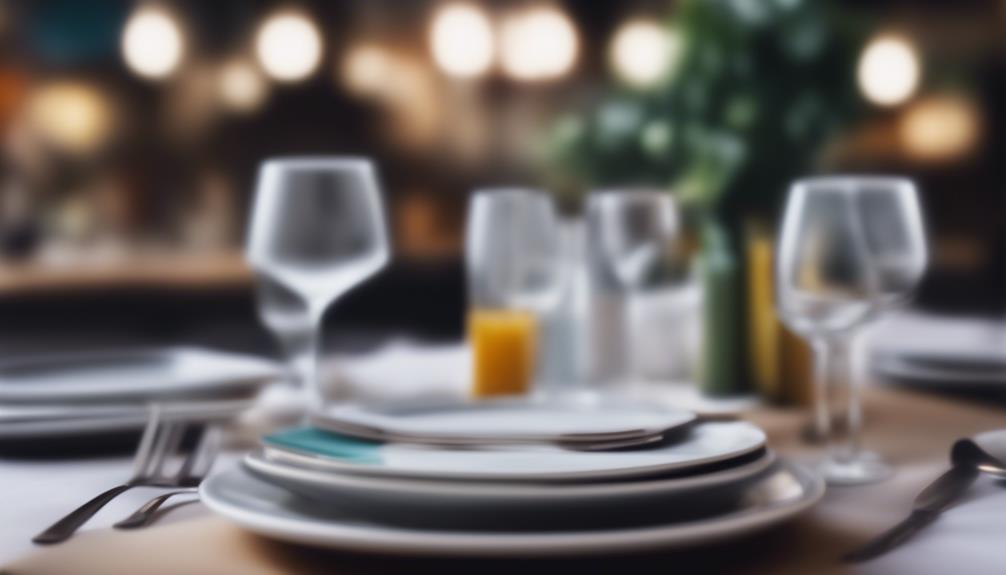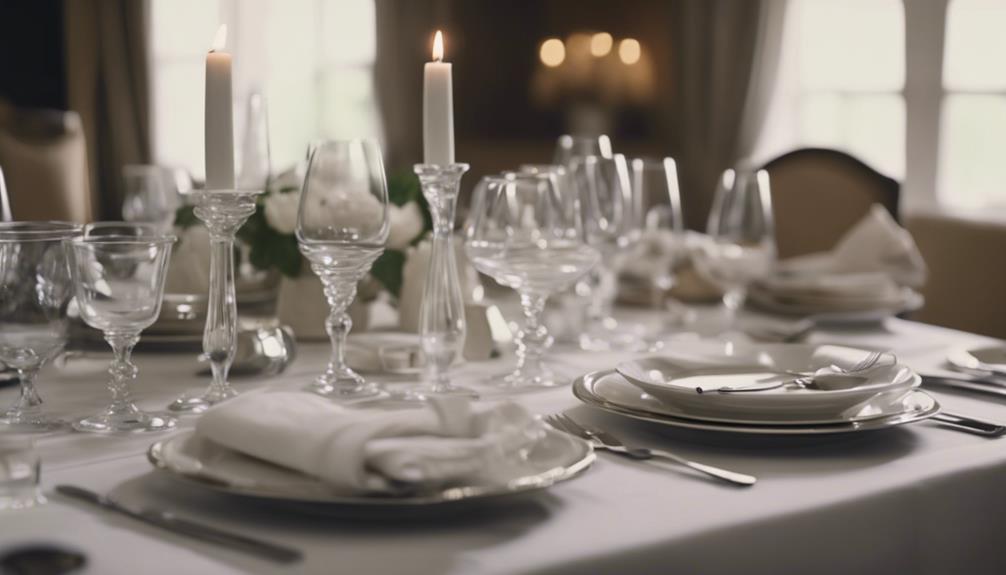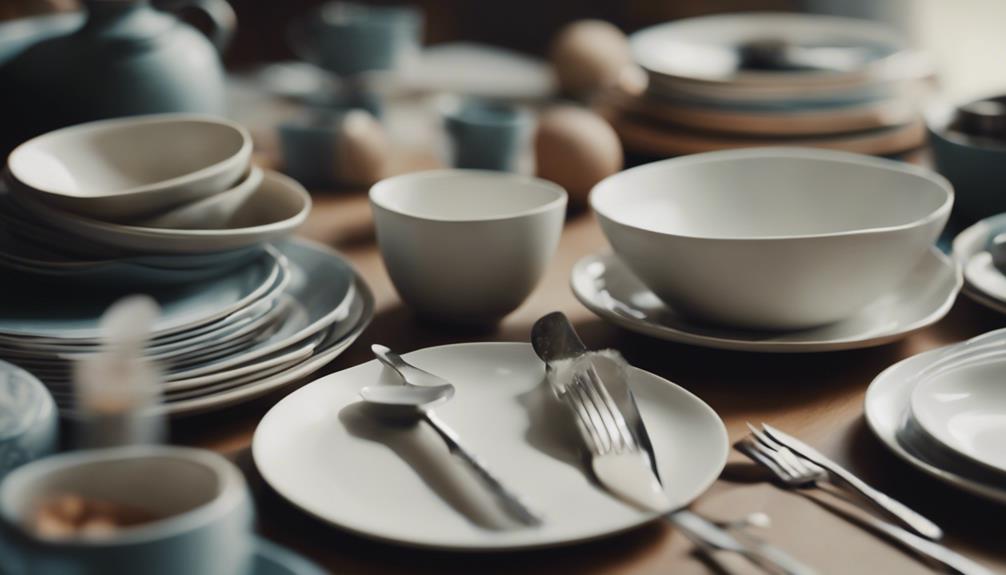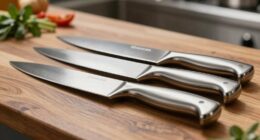When eating out, the tableware at a restaurant plays a crucial role in enhancing your dining experience. It reflects the style of the establishment, sets the tone for the meal, and adds visual appeal with its sturdy designs. There are various types of tableware available, ranging from elegant china to durable porcelain, lightweight melamine, practical plastic, and sleek stainless steel. When selecting tableware, it is important to consider factors such as style, durability, and ease of maintenance. Current trends are moving towards eco-friendly materials and minimalist designs, which are particularly attractive to environmentally-conscious diners. Taking proper care of the tableware through regular inspection and gentle washing ensures its longevity. The tableware significantly impacts the customer experience by influencing perception and satisfaction, contributing to a thoughtful dining environment. Explore more about the importance and trends of restaurant tableware here.
Key Takeaways
- Enhances dining experience with style and visual appeal.
- Reflects establishment's identity and sets meal tone.
- Comes in various types like china, porcelain, melamine.
- Prioritizes durability, safety standards, and menu complementarity.
- Designed with mechanical strength for long-lasting use.
Importance of Restaurant Tableware
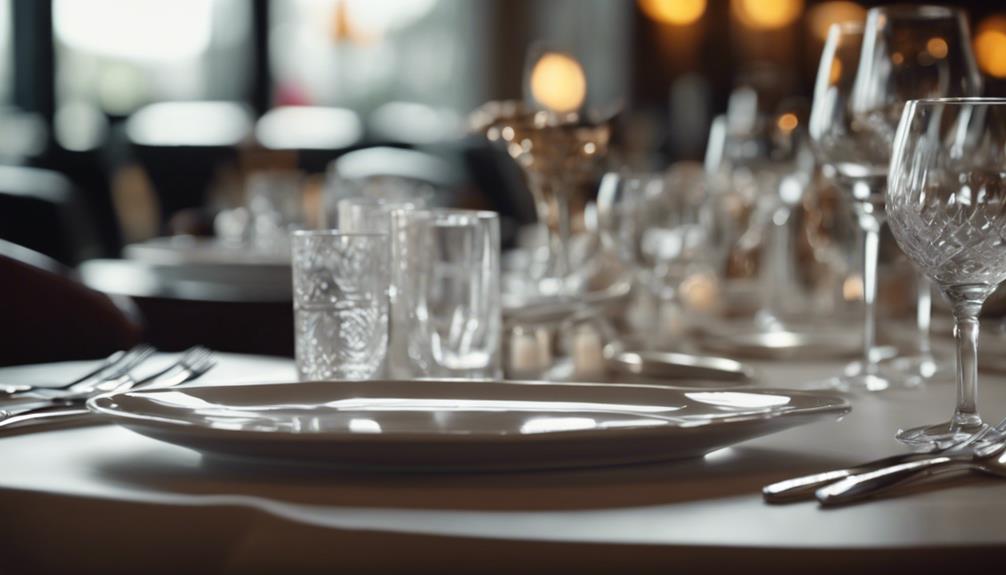
Enhancing the dining experience, restaurant tableware plays an important role in reflecting the establishment's style and setting the tone for your meal. Plates and soup bowls are essential pieces used in restaurants, not only for serving food but also for enhancing the visual appeal of your dining experience. These items are designed with mechanical strength to withstand the rigors of a bustling restaurant environment, ensuring durability and longevity.
The mechanical strength of plates and soup bowls is essential to prevent breakage during busy service hours, maintaining a smooth dining experience for you and other patrons. By using tableware with adequate mechanical strength, restaurants can focus on delivering delicious meals without worrying about frequent replacements due to breakage. This reliability in tableware contributes to a seamless dining experience, allowing you to enjoy your meal without interruptions or inconveniences. As a result, the quality and durability of restaurant tableware play a significant role in enhancing your overall dining experience.
Types of Restaurant Tableware
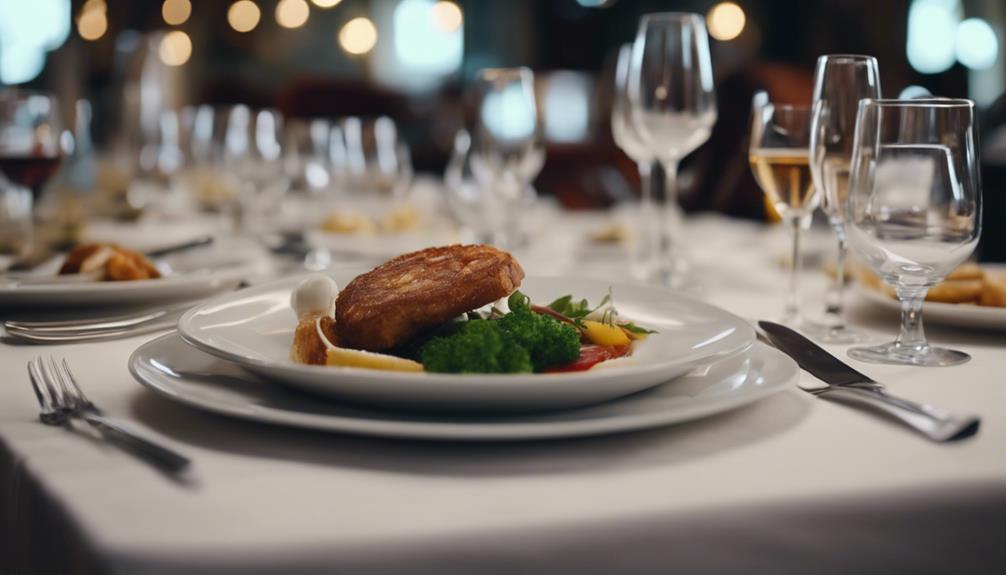
Reflecting the establishment's style and setting the tone for your meal, restaurant tableware comes in various types to cater to different dining needs. Different types of tableware are used in restaurants based on the specific requirements of the dishes being served. Here are some common types of restaurant tableware used:
| Type | Description |
|---|---|
| China | Elegant and delicate, often used for fine dining. |
| Porcelain | Similar to china but more durable and versatile. |
| Melamine | Lightweight and durable, ideal for casual dining. |
| Plastic | Affordable and practical, commonly used for outdoor settings. |
| Stainless Steel | Modern and sleek, providing a contemporary look. |
Each type of tableware used in restaurants has its own characteristics that cater to different dining experiences, from elegant fine dining to casual outdoor settings. Consider the type of cuisine and ambiance of your restaurant when choosing the appropriate tableware to enhance the overall dining experience.
Factors to Consider When Choosing Tableware
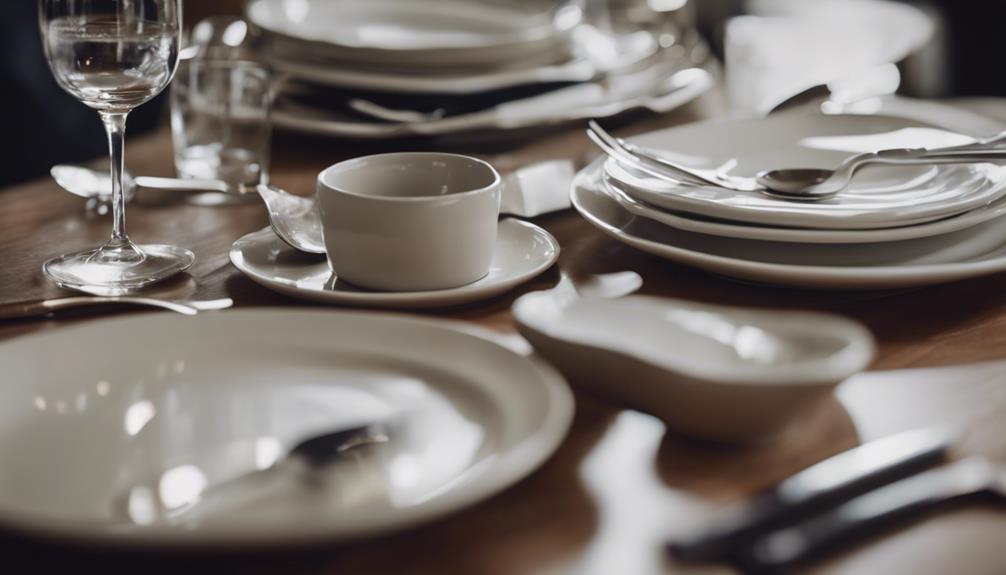
When choosing tableware for your restaurant, consider factors such as style, durability, ease of maintenance, menu complementarity, and safety standards.
Selecting tableware that aligns with your restaurant's style, theme, and ambiance can enhance the overall dining experience for your customers. Prioritize durability and resistance to ensure the longevity of the tableware in a commercial setting, reducing the need for frequent replacements.
Opting for tableware that's easy to clean and maintain can make your operations much easier, especially during peak hours when efficiency is paramount.
Furthermore, choosing tableware that complements your menu offerings can elevate the presentation of dishes, making them more visually appealing to diners. Additionally, ensure that the selected tableware meets safety and hygiene standards to maintain a clean and healthy dining environment for your patrons.
Trends in Restaurant Tableware Design
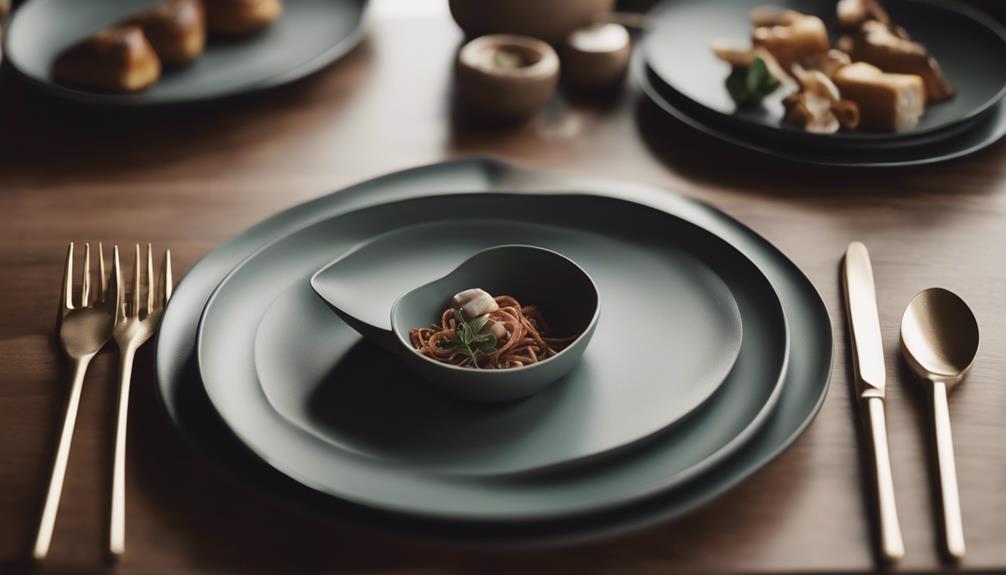
Modern tableware materials like bamboo and recycled glass, minimalist styles with clean lines, and eco-friendly options are the key trends in restaurant tableware design. These elements contribute to a contemporary and sustainable aesthetic, appealing to environmentally-conscious diners and establishments.
Embracing these trends can enhance the overall dining experience and showcase a commitment to both style and social responsibility.
Modern Tableware Materials
Incorporating a variety of innovative materials, contemporary restaurant tableware designs cater to the preferences of eco-conscious consumers while embracing minimalist and geometric patterns for a sleek and modern aesthetic.
To stay in line with current trends, restaurants are opting for materials like melamine, bamboo, and recycled glass, which not only appeal to environmentally conscious diners but also offer durability and style. These materials provide a sustainable option without compromising on design.
Additionally, the use of matte finishes and handcrafted details adds a unique touch to modern tableware collections, creating a sophisticated look that appeals to a wide range of customers.
Minimalist Tableware Styles
For a sleek and sophisticated dining experience, minimalist tableware styles emphasize clean lines and simple shapes to create a modern aesthetic in restaurants. Neutral colors like white, black, and earth tones are commonly used to enhance elegance and versatility. Functionality and practicality are key in minimalist tableware, focusing on sleek and uncluttered aesthetics for a contemporary dining experience. Scandinavian-inspired designs often incorporate natural materials such as wood and stone, adding warmth and texture to the setting. This trend reflects a move towards understated elegance and timeless design in restaurant settings, appealing to customers seeking a refined dining experience.
| Minimalist Tableware Styles | Features |
|---|---|
| Clean lines and simple shapes | Modern aesthetic |
| Neutral colors | Enhance elegance |
| Functionality and practicality | Contemporary experience |
| Natural materials | Warmth and texture |
Eco-Friendly Tableware Options
Eco-friendly tableware options are increasingly gaining popularity in restaurant settings due to their sustainability and reduced environmental impact. Here are three eco-conscious choices worth exploring for your dining establishment:
- Bamboo Tableware: Made from a renewable resource, bamboo tableware is durable, lightweight, and biodegradable, making it an excellent option for eco-friendly dining.
- Recycled Glass Serveware: Incorporating recycled glass in tableware production reduces the need for new raw materials, which helps in lowering energy consumption and greenhouse gas emissions associated with manufacturing.
- Sugarcane Fiber Plates: These plates are compostable and derived from sugarcane fiber, providing a sustainable alternative to traditional paper or plastic plates while supporting waste reduction in your restaurant.
Sustainability in Tableware Choices

When selecting restaurant tableware, consider the sustainability aspect by opting for eco-friendly materials like bamboo or recycled paper.
Reusable options such as stainless steel or glass provide a durable and environmentally conscious choice over disposable alternatives.
Your tableware choices can have a significant impact on reducing waste in landfills and contributing to a more sustainable dining experience.
Eco-Friendly Tableware Materials
Choosing tableware made from eco-friendly materials like bamboo, sugarcane, palm leaf, and cornstarch-based bioplastics is a sustainable and responsible decision for restaurants aiming to reduce their environmental impact. These materials offer several benefits:
- Biodegradable: Eco-friendly tableware materials break down naturally, reducing waste and lessening the burden on landfills.
- Compostable: They can be composted into nutrient-rich soil, supporting a circular economy and reducing greenhouse gas emissions.
- Renewable: Bamboo, sugarcane, palm leaf, and cornstarch are renewable resources, ensuring a long-term supply without depleting natural ecosystems.
Reusable Versus Disposable Options
Shifting from eco-friendly tableware materials, the debate between using reusable and disposable options in restaurant settings is pivotal for sustainability in tableware choices. Reusable tableware options, like ceramic plates and stainless steel cutlery, reduce waste and environmental impact. On the other hand, disposable tableware, such as paper plates and plastic utensils, offer convenience but contribute to landfill waste. Sustainable tableware choices focus on materials like bamboo, sugarcane, and cornstarch for biodegradability. While reusable tableware requires cleaning and maintenance, disposable options provide quick cleanup but lack durability. To balance sustainability and practicality, businesses can offer a mix of reusable and compostable tableware options.
| Feature | Reusable Tableware | Disposable Tableware |
|---|---|---|
| Environmental Impact | Reduces waste and environmental impact | Contributes to landfill waste |
| Materials | Ceramic plates, stainless steel cutlery | Paper plates, plastic utensils |
| Cleanup | Requires cleaning and maintenance | Offers quick cleanup but lacks durability |
Impact on the Environment
To minimize environmental impact and promote sustainability in restaurant settings, consider opting for tableware made from bamboo, recycled materials, or biodegradable products. Here are three sustainable tableware options to help reduce your restaurant's carbon footprint:
- Bamboo Tableware: Bamboo is a renewable resource that grows quickly and requires minimal water and no pesticides, making it an eco-friendly choice for tableware.
- Recycled Materials: Tableware made from recycled materials like glass or plastic helps reduce waste by giving new life to used resources, promoting a circular economy.
- Biodegradable Products: Opt for tableware made from biodegradable materials such as sugarcane or cornstarch, which break down naturally, minimizing environmental impact and reducing landfill waste.
Proper Care and Maintenance of Tableware
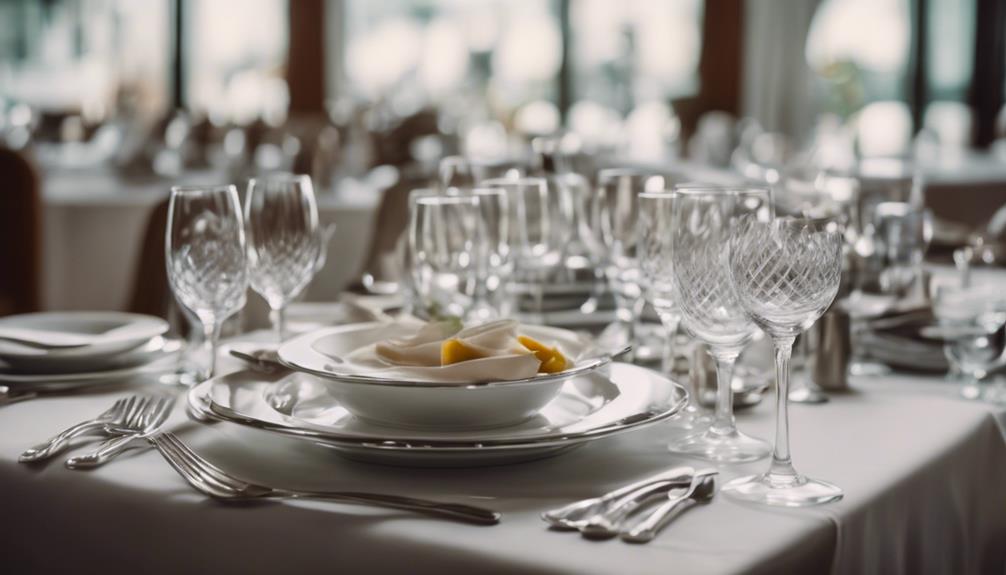
Inspect your tableware regularly for chips, cracks, or stains to promptly address any issues that may arise. Use mild dish soap and a soft sponge for hand washing delicate tableware to prevent damage.
Avoid stacking tableware with metal utensils as this can lead to scratching or chipping. When storing tableware, choose a dry, cool place to prevent damage from humidity or extreme temperatures.
If your tableware is dishwasher-safe, follow the manufacturer's instructions to maintain its quality and appearance over time.
By taking these simple steps, you can guarantee that your restaurant tableware remains in top condition, providing a pleasant dining experience for your customers.
Proper care and maintenance not only extend the lifespan of your tableware but also contribute to the overall presentation and quality of your dining establishment.
Impact of Tableware on Customer Experience
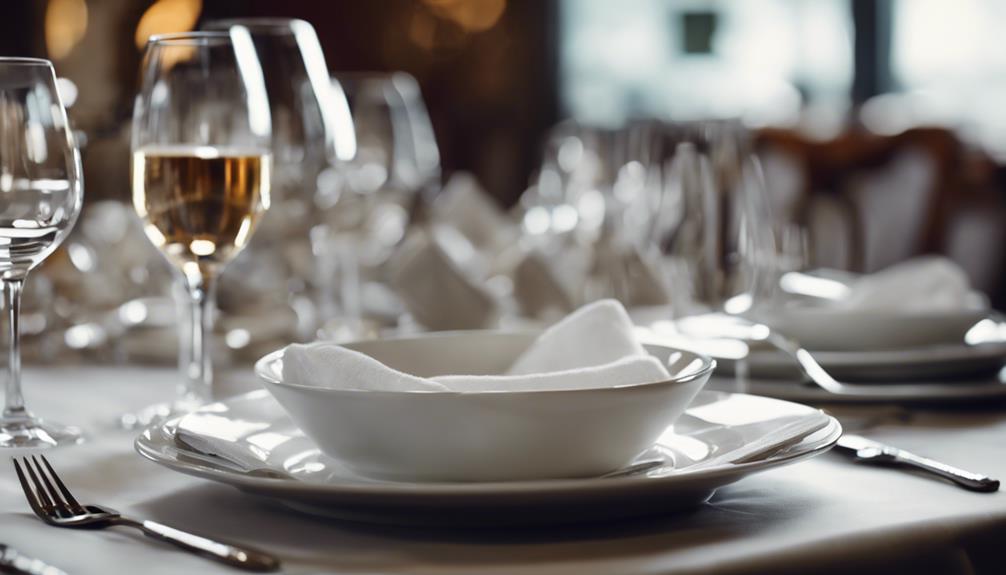
Regularly checking your tableware for any signs of wear and tear is essential in understanding how it impacts the overall dining experience for your customers.
When it comes to the impact of tableware on customer experience, consider the following:
- Perception and Satisfaction: The presentation of food on appropriate tableware can greatly influence how customers perceive the quality of the meal and their overall satisfaction with the dining experience.
- Attention to Detail: Properly chosen tableware reflects attention to detail and contributes to the ambiance of the dining environment, showcasing a level of care and thoughtfulness that customers appreciate.
- Elegance and Sophistication: The right tableware can add an element of elegance and sophistication to the table setting, enhancing the dining experience and making customers feel special and valued.
Frequently Asked Questions
What Is the Definition of Tableware?
Tableware encompasses dishes, utensils, and accessories for setting a table in restaurants. It includes plates, bowls, cups, glasses, cutlery, and serving dishes. Essential for serving food in an appealing way. Quality and design impact the dining experience.
Proper selection enhances ambiance and theme. The arrangement of tableware is vital for organization and visual appeal. Make sure to select and arrange tableware thoughtfully for a great dining experience.
What Is Kitchen Tableware?
In your kitchen, tableware includes plates, bowls, glasses, flatware, and more. These items are essential for serving and enjoying meals at home.
They come in various materials like porcelain and stainless steel, catering to different styles and needs. Having the right kitchen tableware enhances your dining experience and adds a touch of elegance to your meals.
What Are the Four Classifications of Tableware?
When it comes to restaurant tableware, you'll find four main classifications: china, porcelain, melamine, and plastic. Each type offers distinct advantages to suit various dining establishments.
China and porcelain are renowned for their elegance and durability, making them ideal for upscale settings.
On the other hand, melamine is favored for its lightweight and break-resistant nature, while plastic tableware is affordable and easy to maintain, perfect for casual dining spots or outdoor use.
What Is Restaurantware Made Of?
Restaurantware is typically crafted from durable materials like vitrified china, porcelain, or melamine.
Vitrified china is a popular choice for its strong resistance to chipping and scratching. Porcelain is loved for its elegant look, strength, and chip resistance. Melamine is a go-to for outdoor dining spots as it's lightweight and break-resistant.
The material chosen for restaurant tableware depends on factors like cuisine type, budget, and desired aesthetic.
Conclusion
To sum up, restaurant tableware plays a significant role in enhancing the dining experience for customers. From selecting the right types of tableware to embracing sustainability in design, every detail matters.
Proper care and maintenance of tableware can prolong its lifespan and maintain its quality. By staying updated on the latest trends in tableware design, restaurants can create a memorable and enjoyable dining atmosphere for their guests.
Remember, the little things, like tableware, can make a big difference in customer satisfaction.
